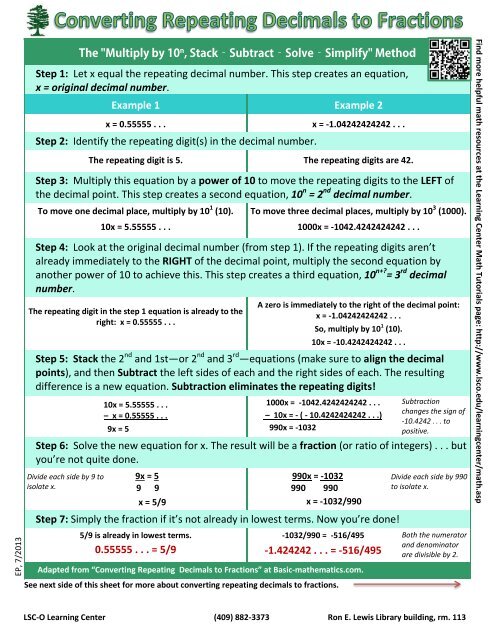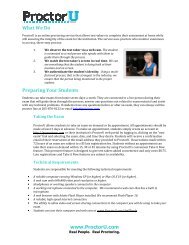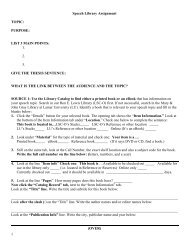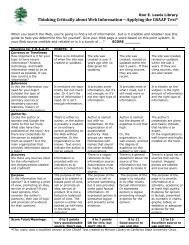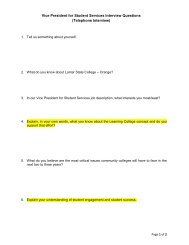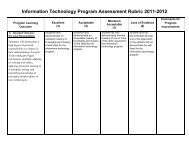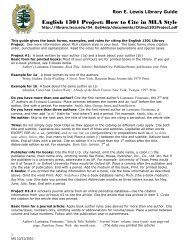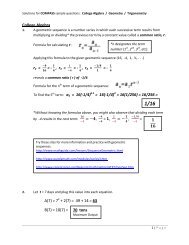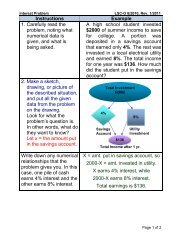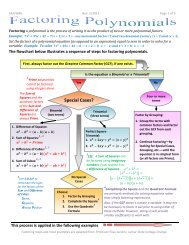You also want an ePaper? Increase the reach of your titles
YUMPU automatically turns print PDFs into web optimized ePapers that Google loves.
The "Multiply by 10 n , Stack–Subtract–Solve–Simplify" Method<br />
Step 1: Let x equal the repeating decimal number. This step creates an equation,<br />
x = original decimal number.<br />
Example 1 Example 2<br />
x = 0.55555 . . . x = -1.04242424242 . . .<br />
Step 2: Identify the repeating digit(s) in the decimal number.<br />
The repeating digit is 5. The repeating digits are 42.<br />
Step 3: Multiply this equation by a power of 10 <strong>to</strong> move the repeating digits <strong>to</strong> the LEFT of<br />
the decimal point. This step creates a second equation, 10 n = 2 nd decimal number.<br />
To move one decimal place, multiply by 10 1 (10).<br />
10x = 5.55555 . . .<br />
To move three decimal places, multiply by 10 3 (1000).<br />
1000x = -1042.4242424242 . . .<br />
Step 4: Look at the original decimal number (from step 1). If the repeating digits aren’t<br />
already immediately <strong>to</strong> the RIGHT of the decimal point, multiply the second equation by<br />
another power of 10 <strong>to</strong> achieve this. This step creates a third equation, 10 n+? = 3 rd decimal<br />
number.<br />
The repeating digit in the step 1 equation is already <strong>to</strong> the<br />
right: x = 0.55555 . . .<br />
A zero is immediately <strong>to</strong> the right of the decimal point:<br />
x = -1.04242424242 . . .<br />
So, multiply by 10 1 (10).<br />
10x = -10.4242424242 . . .<br />
Step 5: Stack the 2 nd and 1st—or 2 nd and 3 rd —equations (make sure <strong>to</strong> align the decimal<br />
points), and then Subtract the left sides of each and the right sides of each. The resulting<br />
difference is a new equation. Subtraction eliminates the repeating digits!<br />
10x = 5.55555 . . .<br />
– x = 0.55555 . . .<br />
9x = 5<br />
1000x = -1042.4242424242 . . .<br />
– 10x = - ( - 10.4242424242 . . .)<br />
990x = -1032<br />
Subtraction<br />
changes the sign of<br />
-10.4242 . . . <strong>to</strong><br />
positive.<br />
Step 6: Solve the new equation for x. The result will be a fraction (or ratio of integers) . . . but<br />
you’re not quite done.<br />
Divide each side by 9 <strong>to</strong><br />
isolate x.<br />
9x = 5<br />
9 9<br />
x = 5/9<br />
990x = -1032<br />
990 990<br />
x = -1032/990<br />
Step 7: Simply the fraction if it’s not already in lowest terms. Now you’re done!<br />
Divide each side by 990<br />
<strong>to</strong> isolate x.<br />
Find more helpful math resources at the Learning Center Math Tu<strong>to</strong>rials page: http://www.lsco.edu/learningcenter/math.asp<br />
EP, 7/2013<br />
5/9 is already in lowest terms.<br />
0.55555 . . . = 5/9<br />
-1032/990 = -516/495<br />
-1.424242 . . . = -516/495<br />
Adapted from “Converting <strong>Repeating</strong> <strong>Decimals</strong> <strong>to</strong> <strong>Fractions</strong>” at Basic-mathematics.com.<br />
See next side of this sheet for more about converting repeating decimals <strong>to</strong> fractions.<br />
Both the numera<strong>to</strong>r<br />
and denomina<strong>to</strong>r<br />
are divisible by 2.<br />
LSC-O Learning Center (409) 882-3373 Ron E. Lewis Library building, rm. 113
The "Break-Down" & "Re-Build" Method<br />
This method may be useful when the repeating digits start several decimal places behind the decimal point.<br />
Step 1: Break down the repeating decimal by expressing it as a sum of fractions, with the<br />
repeating portion at the end (use place values <strong>to</strong> figure this out). You do this in order <strong>to</strong> isolate<br />
the repeating part.<br />
Example<br />
1.873535 . . . = 1/1 + 87/100 + 0.003535 . . . Note that the whole number 1 = 1/1<br />
Step 2: Focus only on the repeating portion of the sum (ignore the rest). Let x = the repeating<br />
portion. Multiply this equation by a power of 10 <strong>to</strong> move the repeating digits immediately <strong>to</strong><br />
the LEFT of the decimal point (in other words, <strong>to</strong> eliminate any zeros preceding the repeating<br />
digits).<br />
x = 0.003535 . . .<br />
100x = 0.353535 . . .<br />
Step 3: Express this new repeating decimal number as a sum in order <strong>to</strong> isolate the repeating<br />
part (refer <strong>to</strong> step 1).<br />
100x = 35/100 + 0.003535 . . .<br />
Step 4: Recall that x = 0.003535 . . . , so you can replace this part with x in the equation above.<br />
100x = 35/100 + x<br />
Step 5: Solve for x. This step should yield the repeating portion expressed as a fraction.<br />
100x = 35/100 + x<br />
– x – x<br />
99x = 35/100<br />
Divide each side by 99 (or multiply by 1/99).<br />
99x * 1/99 = 35/100 * 1/99<br />
Now 0.003535 . . . is a fraction!<br />
x = 35/9900<br />
Step 6: In the sum from step 1, replace the repeating decimal portion with its fractional<br />
equivalent.<br />
1.873535 . . . = 1/1 + 87/100 + 35/9900<br />
Find more helpful math resources at the Learning Center Math Tu<strong>to</strong>rials page: http://www.lsco.edu/learningcenter/math.asp<br />
Step 7: Now that each element of the sum is a fraction, it’s time <strong>to</strong> re-build by adding the<br />
fractions <strong>to</strong>gether. Make sure <strong>to</strong> use a common denomina<strong>to</strong>r. Reduce if needed.<br />
EP, 7/2013<br />
1.873535 . . . = 9900/9900 + 8613/9900 + 35/9900 = 18548/9900 = 4637/2475<br />
1.873535 . . . = 4637/2475<br />
Adapted from College Algebra, 2 nd ed., by Paul Sisson, page 11.<br />
Both the numera<strong>to</strong>r and<br />
denomina<strong>to</strong>r are divisible<br />
by 4.<br />
LSC-O Learning Center (409) 882-3373 Ron E. Lewis Library building, rm. 113


